预约演示
更新于:2025-05-30
EBV TCR T cell therapy (China Immunotech)
更新于:2025-05-30
概要
基本信息
原研机构 |
在研机构- |
非在研机构 |
权益机构- |
最高研发阶段无进展临床2期 |
首次获批日期- |
最高研发阶段(中国)无进展 |
特殊审评- |
登录后查看时间轴
关联
2
项与 EBV TCR T cell therapy (China Immunotech) 相关的临床试验NCT04156217
A Pilot Study of EBV-TCR-T Cells in EB Virus Infection Diseases After HSCT
This is a single center, single arm, open-label, phase I study to evaluate the safety and efficacy of EBV-TCR-T cells in patients with EB virus infection after HSCT.
开始日期2020-02-10 |
申办/合作机构 河北燕达陆道培医院 [+1] |
NCT03648697
A Pilot Study of EBV-TCR-T(YT-E001) in NPC Patients
TCR-T cell therapy experienced a breakthrough for treating tumors in recent years. Phase I / II trial of NY-ESO-1-specific TCR-T treatment for synovial sarcoma and melanoma conducted by the Rosenberg team at the National Cancer Institute showed that 61% Synovial cell sarcoma and 55% melanoma had therapeutic responses. These and lots of clinical achievements indicate that TCR-T cell therapy can target a variety of tumors including solid tumors without any severe side effects found in CAR-T trials.
Nasopharyngeal carcinoma (NPC), a kinds of head-neck malignant tumor, which used to appear mostly in southern China (especially in Fujian and Guangdong and Guangxi provinces). Most patients with NPC show evidence of infection with the Epstein Barr virus (EBV) before or at the time of their diagnosis. EBV is found in the cancer cells of almost all patients with advanced stage NPC, and play a role in causing and inducing the disease program and development. The cancer cells infected by EBV are able to hide from the body's immune system and escape destruction. We want to see if EBV antigen special T cells (YT-E001) could recognize and kill special parts of EBV infected cells, and finally inhibit the tumor recurrence or metastasis of NPC patients.
This study will focus on the NPC highly expressed EBV antigen such as LMP1, LMP2 and EBNA1,the high affinity TCR target the above EBV antigen were screened from the healthy donor using the sorting and single cell cloning technique. Then, using the lentivirus to transduce the TCR gene to the autologous T cells.
This study will investigate the safety and tolerability of EBV-TCR-T cell therapy in subjects with NPC who had received prior therapy for their disease but their disease has progressed or relapsed.
The chemotherapy we will use for lymphodepletion is a combination of cyclophosphamide and fludarabine. Cyclophosphamide and fludarabine are the chemotherapy agents most commonly used for lymphodepletion in immunotherapy clinical trials.
Nasopharyngeal carcinoma (NPC), a kinds of head-neck malignant tumor, which used to appear mostly in southern China (especially in Fujian and Guangdong and Guangxi provinces). Most patients with NPC show evidence of infection with the Epstein Barr virus (EBV) before or at the time of their diagnosis. EBV is found in the cancer cells of almost all patients with advanced stage NPC, and play a role in causing and inducing the disease program and development. The cancer cells infected by EBV are able to hide from the body's immune system and escape destruction. We want to see if EBV antigen special T cells (YT-E001) could recognize and kill special parts of EBV infected cells, and finally inhibit the tumor recurrence or metastasis of NPC patients.
This study will focus on the NPC highly expressed EBV antigen such as LMP1, LMP2 and EBNA1,the high affinity TCR target the above EBV antigen were screened from the healthy donor using the sorting and single cell cloning technique. Then, using the lentivirus to transduce the TCR gene to the autologous T cells.
This study will investigate the safety and tolerability of EBV-TCR-T cell therapy in subjects with NPC who had received prior therapy for their disease but their disease has progressed or relapsed.
The chemotherapy we will use for lymphodepletion is a combination of cyclophosphamide and fludarabine. Cyclophosphamide and fludarabine are the chemotherapy agents most commonly used for lymphodepletion in immunotherapy clinical trials.
开始日期2018-10-10 |
申办/合作机构 |
100 项与 EBV TCR T cell therapy (China Immunotech) 相关的临床结果
登录后查看更多信息
100 项与 EBV TCR T cell therapy (China Immunotech) 相关的转化医学
登录后查看更多信息
100 项与 EBV TCR T cell therapy (China Immunotech) 相关的专利(医药)
登录后查看更多信息
8
项与 EBV TCR T cell therapy (China Immunotech) 相关的文献(医药)2021-10-01·Annals of palliative medicine4区 · 医学
Systematic review and meta-analysis of ureteral stent for risk factors of restenosis after laparoscopic pyeloplasty
4区 · 医学
Review
作者: Feng, Qiang ; Wang, Yu ; Qiu, Mingxing ; Li, Lijun ; Gong, Baisheng
BACKGROUND:
Laparoscopic pyeloplasty (LP) has been widely used to treat ureteropelvic junction obstruction (UPJO); however, no previous series of reports has focused on analyzing the factors that influence the complications and outcomes of LP. In this study, we analyzed the risk factors related to complications of LP, especially that of restenosis. The aim of this study is to perform meta-analysis of relevant comparative studies to analyze the risk factors of restenosis after LP treatment with ureteral stent as of 30 April 2021.
METHODS:
A systematic search was conducted in April 2021. The evaluation results included operation time (OT), intraoperative blood loss (IBL), anastomotic tension (AT), postoperative drainage (PD), and ectopic blood vessels (EBV). Relative risk (RR) and standardized mean difference (SMD) were extrapolated with a 95% confidence interval (CI). Subgroup analysis was performed based on research design and technology.
RESULTS:
After screening, 7 studies were included, incorporating a total of 979 patients with PUJO treated by LP. Analysis revealed the likelihood of risk factors as follows: OT [mean difference (MD) -3.16, 95% CI: -7.18 to 0.85; P=0.12], IBL (MD -3.16, 95% CI: -7.18 to 0.85; P=0.12), AT (RR 3.86, 95% CI: 2.96 to 5.02; P<0.00001), PD (MD 303.97, 95% CI: 219.49 to 388.44; P<0.00001), and EBV (RR 1.15, 95% CI: 0.78 to 1.68; P=0.49). The results indicated that high AT and increased PD are risk factors for postoperative ureteral restenosis.
DISCUSSION:
The results of the meta-analysis showed that among the factors related to the efficacy of LP in the treatment of ureteral stenosis, OT, IBL, AT, and EBV were not significantly correlated with postoperative restenosis. However, AT and PD are independent risk factors for postoperative restenosis of the ureter. Therefore, during the operation, the AT should be reduced, and the local injury is reduced to reduce the PD, thereby reducing the risk of restenosis.
2020-01-01·Lung India : official organ of Indian Chest Society
Bronchoscopic interventions for emphysema: Current status
Review
作者: Munavvar, Mohammed ; Paul, Suman ; Wang, Ran ; Truong, Vi
Chronic obstructive pulmonary disease is a prevalent and progressive disease. The recently developed bronchoscopic lung volume reduction (BLVR) techniques offer personalized therapeutic options in subgroups of patients with severe emphysema. Endobronchial and intrabronchial valves (EBV/IBV) achieve lung volume reduction by lobar atelectasis. The lung volume reduction coils (LVRCs) and bronchoscopic thermal vapor ablation (BTVA) induce tissue compression, either mechanically or through inflammatory processes. While the effects of EBV/IBV are reversible by removing the implants, the effects of LVRC are partially reversible and that of BTVA is irreversible. The presence of interlobar collateral ventilation (CV) impacts on EBV/IBV treatment outcome due to its mechanism of action. Therefore, using radiological and endoscopic techniques to assess CV has a vital importance. Current evidence of BLVR demonstrates acceptable safety and short-term clinical efficacy. However, head-to-head trials are lacking, and further research is needed to establish long-term clinical benefit, durability, and cost-effectiveness of these techniques.
2019-12-01·Journal of viral hepatitis2区 · 医学
Evolution of renal function under direct‐acting antivirals treatment for chronic hepatitis C: A real‐world experience
2区 · 医学
Article
作者: Hung, Chao‐Hung ; Chien, Rong‐Nan ; Chien‐Hung, Chen ; Sheen, I‐Shyan ; Wang, Jing‐Houng ; Hu, Tsung‐Hui ; Tung, Shui‐Yi ; Lin, Chun‐Yen ; Chang, Kuo‐Chin ; Lin, Chih‐Lang ; Lu, Sheng‐Nan ; Tsai, Ming‐Chao
Abstract:
Renal toxicity of direct‐acting antivirals (DAAs) in chronic hepatitis C (CHC) patients has not been well‐characterized. The aim of this study was to assess renal safety of DAAs in an Asian CHC patient cohort. Data from CHC patients (n = 1536) treated with DAAs were used in this retrospective study. Serial estimated glomerular filtration rate (eGFR) at pretreatment (1‐year prior to treatment), baseline, end of treatment (EOT), and 12 weeks after treatment (SVR12) was evaluated. While a significant decrease in eGFR from baseline to EOT (84.8 → 81.8 mL/min/1.73 m2, P < .001) was observed; subsequently, a slight rise at SVR12 (84.3 mL/min/1.73 m2) was also evident. Changes in eGFR after DAA treatment were similar to those seen in PrOD, DCV/ASV and GZP/EBV regimens, except in the SOF‐based regimen wherein eGFR remained unchanged from EOT to SVR12, especially in liver transplant recipients. Multivariate analysis revealed that age >65 years (OR = 1.862, P = .011), baseline eGFR ≥ 60 mL/min/1.73 m2 (OR = 2.684, P = .023), and liver transplant (OR = 3.894, P = .001) were independent risk factors for deteriorating renal function. In conclusion, DAA treatment led to a significant decline in eGFR at EOT but was followed by a slight rise at 12 weeks after treatment. A similar trend was observed with PrOD, DCV/ASV and GZP/EBV, but not in SOF‐based regimens. As age >65 years, baseline eGFR ≥ 60 mL/min/1.73 m2 and liver transplantation are significant risk factors for deterioration in renal function, we strongly advice close monitoring of renal function in these populations.
2
项与 EBV TCR T cell therapy (China Immunotech) 相关的新闻(医药)2024-08-04
据 Insight 数据库统计,本周(7 月 28 日—8 月 3 日)全球共有 72 款创新药(含改良新)研发进度推进到了新阶段,其中 3 款获批上市,1 款申报上市,3 款进入 III 期临床,16 款获批临床,8 款申报临床。
下文,Insight 将分别摘取国内外部分重点项目做介绍。
国内创新药进展
本周国内共有 45 款创新药(含改良新)研发进度推进到了新阶段,其中 1 款启动 III 期临床,16 款新药获批临床,12 款申报临床。
本周国内首次获批临床的 8 款创新药(含改良新)
来自:Insight 数据库网页版
(下文如无特殊标注,为同一来源)
申报上市
1、信达生物:「玛仕度肽」新适应症报上市,治疗 2 型糖尿病
8 月 1 日,CDE 官网公示,信达生物 GLP-1R/GCGR 双重激动剂玛仕度肽注射液的新适应症申报上市,并获得受理。
玛仕度肽的肥胖症上市申请已于今年 2 月获 CDE 受理。根据信达生物公开资料,本次申报的新适应症为 2 型糖尿病。
截图来源:CDE官网
玛仕度肽(研发代号:IBI362)由信达生物与礼来共同开发。作为一种哺乳动物胃泌酸调节素(OXM)类似物,玛仕度肽除了通过激动 GLP-1R 促进胰岛素分泌、降低血糖和减轻体重外,还可通过激动 GCGR 增加能量消耗增强减重疗效,同时改善肝脏脂肪代谢。
玛仕度肽已在多项临床研究中展现出优秀的减重和降糖疗效,以及降低腰围、血脂、血压、血尿酸、肝酶及肝脏脂肪含量,以及改善胰岛素敏感性,带来多重代谢获益。
2024 年 2 月,玛仕度肽的首个 NDA 获 NMPA 受理,用于成人肥胖或超重患者的长期体重控制。Insight 数据库预测,该适应症申请预计将于 2025 年第三季度获批。
玛仕度肽研发历史时光轴
截图来自:Insight 数据库官网
玛仕度肽当前共开展了五项 III 期临床研究,包括:1)在中国超重或肥胖受试者中开展的 III 期临床研究(GLORY-1);2)在中重度肥胖的中国肥胖受试者中开展的 III 期临床研究(GLORY-2);3)在初治的中国 2 型糖尿病患者中开展的 III 期临床研究(DREAMS-1);4)在口服药物治疗血糖控制不佳的中国 2 型糖尿病受试者中开展的对比玛仕度肽和度拉糖肽的 III 期临床研究(DREAMS-2);5)在中国 2 型糖尿病合并肥胖的受试者中开展的对比玛仕度肽和司美格鲁肽的 III 期临床研究(DREAMS-3)。
7 月 22 日,信达生物宣布玛仕度肽在中国 2 型糖尿病受试者中开展的 III 期临床研究(DREAMS-1)达成首要终点和全部关键次要终点,展现出降糖、减重双达标及心血管肾脏代谢指标的综合获益。
此前,玛仕度肽头对头度拉糖肽治疗 2 型糖尿病的 III 期临床 DREAMS-2 也已达成研究终点,玛仕度肽展现出显著优效于度拉糖肽的降糖疗效,并在减重、心血管代谢指标均展示出了更优越的综合获益。
DREAMS-1 研究总览图
截图来自:Insight 数据库官网
2、正大天晴:PD-L1 单抗新适应症报上市,一线治疗肾细胞癌
8 月 1 日,CDE 官网显示,正大天晴自主研发的 PD-L1 单抗贝莫苏拜单抗联合创新药盐酸安罗替尼胶囊的新适应症上市申请已获受理,用于一线治疗晚期不可切除或转移性肾细胞癌(RCC)。
这是贝莫苏拜单抗注射液申报上市的第 3 个适应症,是盐酸安罗替尼胶囊申报上市的第 8 个适应症。本次新适应症的上市申请也是国内首次使用双国产创新药组合一线免疫治疗晚期肾细胞癌。
截图来源:CDE官网
肾癌是泌尿系统最常见的恶性肿瘤之一,RCC 占全部肾癌病例的 80%~90%。据统计,2022 年中国肾癌新发病例和死亡病例分别约为 7.7 万例和 4.6 万例。约三分之一的肾癌患者在初诊时已发生肿瘤远处转移,而局限性患者接受肾切除术后仍有 20-50% 出现肿瘤远处转移。
ETER100 研究(NCT04523272)是一项随机、开放、阳性药物平行对照、多中心 III 期临床研究,旨在评估贝莫苏拜单抗联合盐酸安罗替尼胶囊和对照组一线治疗晚期不可切除或转移性 RCC 的有效性和安全性。研究显示,相较于对照组,贝莫苏拜联合安罗替尼一线治疗晚期 RCC 可显著降低患者的疾病进展或死亡风险,同时改善 ORR、OS 等次要终点。关于详细的研究数据,正大天晴将在近期国际学术大会上公布。
此前,安罗替尼已获《CSCO 肾癌诊疗指南 2023》推荐用于转移性或不可切除性透明细胞肾细胞癌的治疗,随着临床开发不断强化,安罗替尼联合贝莫苏拜单抗有望为晚期肾癌免疫治疗提供新的思路。
拟优先审评
1、康方生物:「依沃西单抗」第 2 项适应症,单药一线治疗 NSCLC
8 月 2 日,据 CDE 官网显示,康方生物全球首创双特异性抗体新药依沃西单抗上市申请拟纳入优先审评,单药用于 PD-L1 阳性(TPS≥1%)EGFR 突变阴性、ALK 阴性局部晚期或转移性 NSCLC 的一线治疗(受理号:CXSS2400080)。
截图来自:CDE 官网
今年 5 月,依沃西单抗已经获批上市,适应症为联合培美曲塞和卡铂用于经 EGFR-TKI 治疗后进展的 EGFR 基因突变阳性的局部晚期或转移性非鳞状 NSCLC 患者的二线治疗。
本次新适应症被纳入优先审评,让依沃西单抗临床应用有望从二线向一线 NSCLC 挺进,以及从联合疗法向单药疗法的扩展,让药物的效能和适应范围得到了显著增强。
依沃西单抗是一款 PD-1/VEGF 双特异性抗体,在 2022 年 12 月与 Summit Therapeutics 达成协议以 50 亿美元总额实现 License out 交易,罕见高额引起行业震动。
基于康方 Tetrabody 技术设计,依沃西单抗可阻断 PD-1 与 PD-L1 和 PD-L2 的结合,并同时阻断 VEGF 与 VEGF 受体的结合。其抗 PD-1 端采用派安普利单抗的结构,抗 VEGF 端则采用贝伐珠单抗结构。
PD-1 抗体与 VEGF 阻断剂的联合疗法在多种瘤种(如肾细胞癌、非小细胞肺癌和肝细胞癌)中展现出显著的疗效。这主要归因于 VEGF 和 PD-1 在肿瘤微环境中的共表达,使得联合疗法能够更为有效地抑制肿瘤。
然而,依沃西单抗作为单一药物能够同时阻断这两个靶点,或许在增强抗肿瘤活性方面更具优势。初步临床数据显示,依沃西单抗表现出卓越的抗肿瘤效果,其整体疗效优于单一 PD-1 抗体,且减少了抗血管生成相关的严重出血风险等常见严重不良反应。
值得注意的是,依沃西单抗在针对 PD-L1 表达阳性的局部晚期或转移性 NSCLC 的 III 期注册临床研究(HARMONi-2 或 AK112-303)中,与帕博利珠单抗作为一线治疗的对比数据表现出显著优势。
结果表明,依沃西单抗在 PD-L1 TPS 1-49% 和 PD-L1 TPS ≥50% 人群中均显著延长了无进展生存期(PFS)。各亚组分析显示,无论是鳞癌、非鳞癌患者,还是有无肝转移、脑转移的患者,依沃西单抗均展现了强阳性的疗效。此外,依沃西单抗组的总体安全性良好,未出现新的安全性信号。依沃西单抗因此成为全球首个且唯一在 III 期单药头对头临床研究中疗效显著优于帕博利珠单抗的药物。
目前在国内,依沃西单抗一线治疗鳞状 NSCLC 的研究已进入临床 III 期阶段。此外,针对卵巢上皮癌、胆道癌、肝细胞癌及结直肠癌等多种适应症的研究也已进入临床 II 期。
截图来自:Insight 数据库官网
III 期临床试验
1、第一三共:B7-H3 靶向 ADC 在中国启动 Ⅲ 期临床,治疗小细胞肺癌
7 月 29 日,中国药物临床试验登记与信息公示平台显示,第一三共登记了一项 B7-H3 靶向 ADC DS-7300a 的 Ⅲ 期临床试验。该研究拟在复发性小细胞肺癌(SCLC)受试者中比较 DS-7300a 与医生所选治疗的安全性和有效性。
根据 Insight 数据库显示,DS-7300a 此前已在海外进入 Ⅲ 期临床,是全球范围内首个进入 Ⅲ 期临床的 B7-H3 靶向 ADC。
截图来自:药物临床试验登记与信息公示平台
B7-H3 是一种跨膜蛋白,和 PD-L1 同属于 B7 家族。研究发现,B7-H3 在多种癌症类型的肿瘤细胞中都存在过度表达,包括肺癌、前列腺癌和食管癌等。而在小细胞肺癌中,大约 65% 的患者肿瘤中都呈现 B7-H3 高表达的现象。这使其成为了癌症领域一个有前景的治疗靶点。特别是在缺药的小细胞肺癌领域,B7-H3 已展现出了较为惊艳的治疗效果。
DS-7300a(Ifinatamab Deruxtecan,I-DXd)是一款潜在 first-in-class 靶向 B7-H3 的 ADC。该药采用第一三共独有的 DXd ADC 技术设计,由人源化抗 B7-H3 IgG1 单克隆抗体通过可裂解四肽连接子与拓扑异构酶 I 抑制剂有效载荷(一种依喜替康衍生物,DXd)连接组成。
第一三共曾在 2023 年 9 月披露了 DS-7300a 在一项治疗晚期小细胞肺癌患者的 Ⅰ/Ⅱ 期临床研究的亚组分析结果,DS-7300a 表现出了持久的疗效。数据如下:
截图来自:Insight 数据库网页版
本次在中国登记的是一项随机、开放、国际多中心 Ⅲ 期临床试验(IDeate Lung02,CTR20242805),该研究是全球多中心研究 IDeate Lung02 的一部分,在全球范围内于今年 1 月首次在 ClinicalTrials.gov 平台登记,国内预期纳入 70 名患者。
根据 Insight 数据库,全球范围内尚未有靶向 B7-H3 的药物获批用于治疗任何癌症,但已有 50 个靶向 B7-H3 的项目进入到临床阶段,这些药物类型包括 CAR-T、ADC、双特异性抗体、放射性药物等等。
具体到靶向 B7-H3 的 ADC 领域,全球已有 14 个项目进入到临床阶段。从研发进度来看,目前只有第一三共的 DS-7300a 和翰森制药的 HS-20093 进入到 Ⅲ 期临床试验。值得注意的是,DS-7300a 和 翰森 B7-H3 ADC 在国内登记 Ⅲ 期临床时间仅差 7 天,可见竞争之激烈。
B7-H3 靶向 ADC 国内研进度
截图来自:Insight 数据库网页版
2、阿斯利康:C5 补体抑制剂国内启动 III 期临床
7 月 31 日,根据药物临床试验登记与信息公示平台,阿斯利康启动了一项国内 III 期临床试验。该试验是一项单臂、开放标签、多中心研究,旨在评估瑞利珠单抗(Ravulizumab,商品名 Ultomiris)在初治成人阵发性睡眠性血红蛋白尿症(PNH)患者中的有效性、安全性、药代动力学、药效学和免疫原性。
截图来自:药物临床试验登记与信息公示平台
瑞利珠单抗是 Alexion 公司开发的长效 C5 单克隆抗体,独特的设计让它具有比第一代 C5 补体抑制剂更长的半衰期。在治疗 PNH 患者时,它只需每 8 周静脉给药一次就可以有效控制溶血的发生。
目前,瑞利珠单抗已经在国外批准多种自身免疫性疾病,包括 PNH、非典型溶血性尿毒症综合征(aHUS)、重症肌无力以及视神经脊髓炎。
PNH 是一种由于多能造血干细胞层面的糖化磷脂酰肌醇 A 类(PIGA)基因体细胞突变引起的罕见疾病。尽管被视为良性疾病,但在传统治疗手段下,患者的生存率仍然亟需改善。
除瑞利珠单抗外,阿斯利康的另一款 C5 单克隆抗体依库珠单抗(最初由 Alexion 开发)早在 2018 年于我国获批上市,用于治疗 PNH,后续它还获批了抗乙酰胆碱受体(AChR)抗体阳性的难治性全身型重症肌无力(gMG)和 aHUS 两个罕见病适应症。
在今年 2 月和 4 月,PNH 治疗领域迎来了两款新药的获批,分别是罗氏的可伐利单抗和诺华的伊普可泮。此外,越来越多的药企也在 PNH 治疗方面加紧布局。2024 年 5 月 28 日,再鼎医药与合作伙伴再生元启动了 C5 抗体 Pozelimab 和 C5 siRNA 疗法 Cemdisiran 联合治疗 PNH 的 III 期临床试验。
国内药企在 PNH 治疗领域也表现积极。目前,恒瑞医药的 HRS-5965、科越医药的 KP104、天辰生物的 LP-005 以及美悦生物的 MY008211A 均已进入临床 II 期阶段。
3、施维雅:IDH1/2 双重抑制剂在中国启动 Ⅲ 期临床,治疗脑胶质瘤
本周,中国药物临床试验登记与信息公示平台显示,施维雅在中国登记了一项 Ⅲ 期临床试验,旨在评估 Vorasidenib(S095032/AG881)治疗携带 IDH1 或 IDH2 突变的残留或复发性 2 级胶质瘤亚洲受试者的效果和安全性。
今年年初,美国 FDA 和欧盟 EMA 已受理了该药的上市许可申请。根据 Insight 数据库,这也是全球范围内首个申报上市的 IDH1/2 双靶点抑制剂。
截图来自:药物临床试验登记与信息公示平台
脑胶质瘤是一种起源于神经胶质细胞的肿瘤,是最常见的原发性颅内肿瘤。在中国,脑胶质瘤年发病率为 5~8/10 万,5 年病死率在全身肿瘤中仅次于胰腺癌和肺癌。当前,脑胶质瘤治疗以手术切除为主,结合放疗、化疗等综合治疗方法,临床上的治疗目标是尽可能延长患者的无进展生存期和总生存期,同时提高患者的生活质量。
Vorasidenib 是施维雅在 2020 年通过收购 Agios 公司所得的一款口服、选择性、高度脑渗透性的双重抑制剂,针对突变型异柠檬酸脱氢酶 1 和 2(IDH1 和 IDH2),拟开发用于治疗携带 IDH 突变的低级别弥漫性脑胶质瘤。
2023 年 3 月,Vorasidenib 的全球、随机、双盲、Ⅲ期临床试验 INDIGO 研究(NCT04164901)达到了主要终点及关键次要终点,该试验旨在患有 IDH1 或 IDH2 突变的残留或复发性 2 级少突或星形胶质瘤且仅接受过手术治疗的患者中,比较 Vorasidenib 与安慰剂的疗效。试验数据如下图显示:
Ⅲ 期临床试验 INDIGO 研究总览图
截图来自:Insight 数据库网页版
施维雅本次在中国登记的是一项多中心、随机、双盲、安慰剂对照 III 期研究,研究的目的是在携带 IDH1 或 IDH2 突变的残留或复发性 2 级胶质瘤亚洲受试者中评估 Vorasidenib 的有效性、安全性和药代动力学(PK)特征。
IDH 是抗肿瘤药物研发领域的重要靶点之一。全球范围内,已有 3 款 IDH 单靶点抑制剂获批上市,用于治疗不同各类型的癌症,但尚未有 IDH 双靶点抑制剂获批。
除 Vorasidenib 外,和黄医药的 HMPL306 是全球研究进度第二快的 IDH1/2 双靶点抑制剂,已进入 Ⅲ 期临床。其它已进入临床阶段的同类在研药物还有贝达药业的 BPI-221351、礼来的 LY3410738、Nerviano Medical Sciences 的 NMS-173。
全球IDH1/2 双靶点抑制剂管线研究进度
截图来自:Insight 数据库网页版
获批临床
1、恒瑞医药:1 类新药 HRS-6209 乳腺癌联合疗法获批临床
7 月 31 日,恒瑞医药宣布子公司山东盛迪医药收到国家药品监督管理局核准签发的《药物临床试验批准通知书》,同意开展一项 HRS-6209 联合 HRS-1358 或 HRS-8080 或芳香化酶抑制剂或氟维司群用于乳腺癌的治疗的临床试验。
其中,HRS-1358 是恒瑞医药自主研制的新型、高效、选择性的靶向雌激素受体(ER)降解的 PROTAC 分子,能够高选择性地降解 ER,抑制 ER 转录活性及下游信号,进而抑制肿瘤细胞增殖,发挥抗肿瘤作用。
HRS-8080 是恒瑞医药自主研发的新型、高效、选择性的口服雌激素受体(ER)降解剂。可高选择性地降解 ER,抑制 ER 活性及下游信号,进而抑制肿瘤细胞增殖,拟用于 ER 阳性及 ER 突变的乳腺癌的治疗。
HRS-6209 是恒瑞医药自主研发的新型、高效、选择性 CDK4 抑制剂,能够抑制 CDK4/cyclinD 复合物及下游信号,诱导肿瘤细胞阻滞在 G1 期,进而发挥抗肿瘤作用,临床拟用于恶性肿瘤治疗。
乳腺癌是世界范围内最常见的恶性肿瘤。根据 2024 年全球癌症流行病学报告,乳腺癌的发病率和死亡率均位居女性恶性肿瘤首位,全球每年乳腺癌新发病例数约 231 万,死亡 67 万,位居女性恶性肿瘤发病率和死亡率首位。
境外创新药进展
境外部分,本周共有 28 款创新药(含改良新)研发进度推进到了新阶段,其中 3 款获批上市,1 款申报上市,6 款获批临床。
新药获批上市
1、全球首款!TCR-T 细胞疗法获批上市
8 月 1 日,Adaptimmune Therapeutics 公司宣布,美国 FDA 加速批准 TECELRA® (Afamitrisgene autoleucel) 上市,用于治疗患有不可切除或转移性滑膜肉瘤的成人患者,这些患者之前接受过化疗,HLA-A*02:01P、-A*02:02P、-A*02:03P 或 -A*02:06P 呈阳性,并且其肿瘤表达 MAGE-A4 抗原。
值得一提的是,TECELRA 不仅是全球首个获批上市的实体瘤癌症 T 细胞疗法,也是全球首款获批上市的 TCR-T 细胞疗法。
截图来自:Adaptimmune 官网
软组织肉瘤有 50 多种类型,可根据肿瘤出现在脂肪、肌肉、神经、纤维组织、血管或深层皮肤组织中的情况进行分类。滑膜肉瘤约占所有软组织肉瘤的 5% 至 10%。三分之一的滑膜肉瘤患者在 30 岁以下被诊断出患有该病。转移性疾病患者的五年生存率约为 20%,大多数接受晚期疾病标准护理治疗的患者都会经历复发,并需要接受多种疗法,这类患者急需新的治疗选择。
TECELRA 是一种针对黑色素瘤相关抗原 A4 (MAGE-A4) 的工程化 TCR-T 细胞疗法。TECELRA 使用每个患者自身的免疫细胞在一次性输注治疗中识别和攻击癌细胞,这与目前晚期滑膜肉瘤的治疗标准有显著不同。此项批准为被诊断患有这种肉瘤的患者提供了新的选择。
ECELRA 的获批是基于 SPEARHEAD-1 研究队列 1 的结果,该试验纳入了 44 名患者。主要疗效结果是独立审查委员会确定的总缓解率 (ORR)。数据显示,患者的 ORR 为 43%,完全缓解率为 4.5%。中位缓解持续时间为 6 个月(95% CI:4.6,未达到)。在对治疗有反应的患者中,39% 的患者缓解持续时间为 12 个月或更长时间。
根据 Insight 数据库,全球范围内有 150 多个 TCR-T 在研项目处于临床试验阶段。在国内,目前也有 60 个 TCR-T 在研项目已进入或者获批临床。其中,香雪生命科学的 TAEST16001 注射液是和华夏英泰的 YT-E001 国内进度最快,均已进入到 Ⅱ 期临床阶段。
截图来自:Insight 数据库官网
2、口服治疗!阿尔茨海默病又一新药获 FDA 批准
7 月 30 日,Alpha Cognition 官网显示,FDA 批准 Benzgalantamine(ALPHA-1062)用于治疗轻中度阿尔茨海默病(AD)。
Benzgalantamine 是用于 AD 治疗的新型前药,融合了加兰他敏和乙酰胆碱酯酶抑制剂(AChEI)的双重作用机制,通过通过抑制乙酰胆碱的分解来发挥治疗效果。此外,Benzgalantamine 还是 α-7 烟碱型乙酰胆碱受体和 α4β2 受体的变构增强剂,这一特性能够促进突触前神经元释放乙酰胆碱,从而在临床上具有重要意义。
Benzgalantamine 针对 AD 症状,为患者提供持久的认知和整体功能改善,并提高其日常活动能力。自 2001 年加兰他敏获得 FDA 批准以来,已积累了大量长期临床数据,证明其在多种脑受体中的活性、抗炎作用,以及对记忆和注意力的显著改善,且与显著降低死亡风险相关。在 AChEI 类药物中,加兰他敏对认知衰退的影响最为显著,并降低了发展为严重痴呆的风险。
由于 Benzgalantamine 的前药特性,使其在通过胃肠道后能够有效转化为加兰他敏的活性成分,进而实现与加兰他敏相同的治疗效果。更为重要的是,该药物通过独特设计消除药物在胃肠道中的吸收,从而可能解决一些常见的耐受性问题,并具有无失眠发生率的中枢神经系统安全性。
从临床研究来看,在 I 期单次递增剂量(SAD)和多次递增剂量(MAD)试验中,Benzgalantamine 在年轻和老年健康受试者中显示了改善胃肠道副作用和增强认知的作用。MAD 研究中进一步分析的定量脑电图(qEEG)数据表明,Benzgalantamine 在健康老年受试者中显著改善了 AD 指数,在第 7 天用药前和所有用药后时间点均优于安慰剂。此外,几项其他 qEEG 功能测量的变化也表明 Alpha-1062 对大脑功能具有积极影响。
另一项双治疗、双周期、交叉设计试验的顶线结果证实,在接受稳定状态治疗的健康成年志愿者中,ALPHA-1062 与氢溴酸加兰他敏缓释剂具有生物等效性。
截图来自:Insight 数据库官网
AD 是常见的神经退行性疾病,是老年人痴呆的主要原因。目前,全球 AD 患者人数已超过 5000 万,疾病负担不容忽视。由于 AD 病理机制复杂,药物研发难度大,近年来全球范围内获批治疗 AD 药物非常有限。
2021 年 6 月,FDA 批准了由卫材和渤健联合开发的 Aβ 单克隆抗体药物 Aducanumab 上市,用于治疗 AD 相关的轻度认知障碍(MCI),这是 AD 领域近 20 年来首个获批的新药。2023 年 1 月,卫材和渤健联合开发的另一款新药仑卡奈单抗获得 FDA 批准,用于治疗伴有轻度认知功能障碍或轻度痴呆的早期 AD 患者。7 月 2 日,礼来的 Donanemab 也获 FDA 批准上市,适用于治疗早期有症状的 AD,包括因 AD 引起的轻度认知障碍以及轻度 AD。
在 AD 治疗这一领域,国内药企也积极参与其中。长春华洋自主研发的琥珀八氢氨吖啶在 Ⅲ 期临床试验揭盲中显示初步疗效,并于 7 月 24 日提交上市申请。此外,恒瑞医药的 SHR-1707 和卓凯生物的 ZK50561 目前处于 Ⅱ 期临床阶段,康诺亚的 CM383 和绿叶制药的 LPM526000133 也已进入 Ⅰ 期临床阶段。
新适应症获批
1、强生制药:达雷妥尤单抗(皮下注射)四联疗法获 FDA 批准
7 月 30 日,强生宣布,美国 FDA 批准 DARZALEX FASPRO®(达雷妥尤单抗和透明质酸酶-fihj)与硼替佐米、来那度胺和地塞米松 (D-VRd) 联合用于新诊断的多发性骨髓瘤 (NDMM) 患者的诱导和巩固治疗,这些患者适合接受自体干细胞移植 (ASCT)。患者将有机会在初次诊断时接受这种基于 DARZALEX FASPRO® 的四联疗法,为他们提供一种可能显著改善结果的新疗法。
截图来自:强生官网
DARZALEX FASPRO®于 2020 年 5 月获得美国 FDA 批准,获批用于治疗九种多发性骨髓瘤适应症,其中四种用于适合或不适合移植的新诊断患者的一线治疗。它是唯一获批用于治疗多发性骨髓瘤患者的皮下 CD38 靶向抗体。
本次的新适应症批准得到了 Ⅲ 期 PERSEUS 研究数据的支持,该研究评估了 DARZALEX FASPRO® 在包括 D-VRd 诱导和巩固治疗的方案中的效果,并与适合 ASCT 的 NDMM 患者在诱导和巩固期间使用硼替佐米、来那度胺和地塞米松 (VRd) 进行了比较。巩固治疗后,患者接受了一项研究性维持治疗方案,包括 DARZALEX FASPRO 与来那度胺联合使用或单独使用来那度胺。
PERSEUS 研究结果显示,主要终点无进展生存期 (PFS) 显著改善。与 VRd 相比,D-VRd 将疾病进展或死亡风险降低了 60%。与 VRd 相比,使用 D-VRd 诱导和巩固治疗在巩固期结束时可产生更深的反应:微小残留病灶 (MRD) 阴性率为 57.5% vs. 32.5%,完全缓解 (CR) 或更好的患者的 MRD 阴性率为 76.6% vs. 58.5%。
D-VRd 的整体安全性与 DARZALEX FASPRO®和 VRd 的已知安全性一致。接受 D-VRd 治疗的多发性骨髓瘤患者最常见的不良反应 (≥20%) 是周围神经病变、疲劳、水肿、发热、上呼吸道感染、便秘、腹泻、肌肉骨骼疼痛、失眠和皮疹。
2、GSK:PD-1 单抗获批新适应症,针对子宫内膜癌
8 月 1 日,GSK 官网宣布,FDA 批准 Dostarlimab 联合卡铂和紫杉醇,随后 Dostarlimab 作为单一药物治疗原发性晚期或复发性子宫内膜癌的成人患者。
在此之前,Dostarlimab 已获批用于联合化疗治疗具有错配修复缺陷(dMMR)或微卫星不稳定性高(MSI-H)的原发性晚期或复发性子宫内膜癌成年患者。
此次适应症获批,覆盖了具有错配修复功能正常(MMRp)或微卫星稳定(MSS)肿瘤的患者。此类患者占子宫内膜癌患者的 70-75%,且其治疗选择较为有限。
Dostarlimab 是针对程序性细胞死亡受体-1(PD-1)的免疫检查点抑制剂。该药物联合化疗是目前唯一一种在成人原发性晚期或复发性子宫内膜癌患者中,无论其生物标志物状态如何,均能显著提高 OS 的免疫肿瘤疗法。
此次适应症扩展的批准基于 RUBY III 期临床试验第一部分的双主要终点——PFS 和 OS 的结果。RUBY 试验第一部分是唯一一个在此临床背景下显示出在原发性晚期或复发性子宫内膜癌全体患者中具有统计学显著 OS 获益的试验。数据显示,与单纯化疗相比,联合化疗组的死亡风险降低了 31%(HR:0.69;95% CI:0.54–0.89)。
在 2.5 年的随访时间点上,联合化疗组患者的生存率为 61%(95% CI:54-67),而单纯化疗组为 49%(95% CI:43-55)。此外,Dostarlimab 联合化疗组的中位 OS 较单纯化疗组延长了 16.4 个月。安全性和耐受性分析显示,Dostarlimab 联合卡铂和紫杉醇的安全性概况与各单独药物的已知安全性概况一致。
除子宫内膜癌外,Dostarlimab 目前获批的适应症还包括子宫内膜癌、结直肠癌、错配修复缺陷(dMMR)的复发性或晚期实体瘤。根据 GSK 此前发布的财报,在 Q2 期间,该药物强劲增长,销售额达 1.08 亿英镑。
目前,Dostarlimab 用于一线治疗头颈部鳞状细胞癌的 III 期临床试验正在国内进行。
医药交易
1、勃林格殷格翰:13 亿美元!收购 Nerio Therapeutics 公司,拓展免疫肿瘤产品管线
8 月 1 日,勃林格殷格翰宣布在免疫肿瘤产品管线上迈出了重要一步,公司以高达 13 亿美元的总价收购了 Nerio Therapeutics 公司,为产品管线增加了一项创新的临床前项目。勃林格殷格翰旨在推动该项目成为其免疫肿瘤产品组合的潜在关键核心部分,以改善肿瘤患者的治疗效果。
Nerio 的多个小分子可抑制作为免疫检查点的蛋白酪氨酸磷酸酶 N1 和 N2(PTPN1 和 PTPN2)。通过这种机制,PTPN1/N2 抑制剂可以激活免疫系统来对抗肿瘤细胞。
当前的免疫检查点抑制剂已为癌症治疗领域带来了变革。然而,这种疗法并没有为所有患者带来治疗获益。勃林格殷格翰致力于改变这一现状,通过基于免疫检查点阻断的全面产品管线,增强免疫系统并直接针对肿瘤细胞,让免疫肿瘤的优势惠及更多患者。Nerio 的小分子抑制剂有潜力作为单一药物疗法成为勃林格殷格翰产品组合的重要补充,而且重要的是,也能够与公司自主开发的多款肿瘤疗法进行联合用药。
此次收购是在显著改善肿瘤治疗上迈出的大胆一步,这进一步加强了勃林格殷格翰的肿瘤产品管线,将在研的免疫肿瘤疗法和肿瘤细胞靶向疗法巧妙结合,为患者提供最大获益可能。
Nerio Therapeutics 公司是一家专注于磷酸酶的药物发现和开发公司。磷酸酶是一类众所周知难以成药的潜在高价值治疗性蛋白靶点。Nerio 开发了具有出色药物特性的新型、强效且高度选择性的 PTPN2/N1 抑制剂。Nerio 首创的 PTPN2/N1 抑制剂可增强免疫功能并使肿瘤对促炎信号敏感,从而促进强大的抗肿瘤活性。
Nerio 由 Avalon Ventures 创立,并获得了 Bregua Corporation、Correlation Ventures、Alexandria Venture Investments 和 Viva BioInnovator 等投资机构的额外资金支持。Nerio 是依托 Avalon BioVentures 加速器发展而来,受益于 Avalon BioVentures 加速器在早期药物开发的专长和全面的公司支持。
2、勃林格殷格翰:投资生葆生物,加速推进溶瘤细菌管线
7 月 30 日,勃林格殷格翰宣布投资深圳市生葆生物科技有限公司(Synthetica),以加速推进生葆生物的溶瘤细菌管线进入临床试验阶段。该项投资凸显了勃林格殷格翰致力于推进新一代肿瘤疗法的承诺。
生葆生物是一家总部位于中国深圳的生物科技公司,公司旨在通过人工基因线路精确调控活菌基因,将治疗性蛋白质更精确地输送到肿瘤细胞。合成生物学使肿瘤治疗性细菌的设计成为可能,这些细菌仅在识别特定的肿瘤微环境后才释放其有效载荷,它们只会在肿瘤内生长,而不会在肿瘤外部生长。
该项投资为首轮融资,由勃林格殷格翰风险基金(BIVF)和淡马锡领投,联想创投、复健资本和飞镖夏焱基金跟投。去年,勃林格殷格翰通过收购 T3 Pharmaceuticals 公司,为公司研发管线增加了一个细菌肿瘤治疗平台,该平台可以将免疫调节蛋白输送到肿瘤细胞和肿瘤微环境中。
尽管免疫疗法极大地改变了肿瘤治疗格局,但只有 15%-20% 的肿瘤患者能够获得长期缓解。勃林格殷格翰致力于改变这一现状,通过全面的管线产品让免疫肿瘤疗法的优势惠及更多患者,这些疗法可以增强免疫系统并直接针对肿瘤细胞。下一代抗肿瘤细菌疗法平台与其他免疫肿瘤疗法和肿瘤靶向疗法巧妙结合,有可能进一步增加肿瘤患者的获益。
勃林格殷格翰全球风险投资负责人 Frank Kalkbrenner 表示:「溶瘤细菌疗法是勃林格殷格翰风险基金的战略重点,该疗法是一种基于具有多种治疗活性的各类细菌菌株的全新治疗方式。去年收购 T3 Pharma 公司已经成功为勃林格殷格翰产品管线增添了一个治疗平台。我们很高兴能够支持生葆生物推进基于合成生物学技术的下一代细菌疗法,从而最终改变更多肿瘤患者的生命。」
3、百奥赛图:B7H3/PTK7 双特异性 ADC 项目达成选择权和许可协议
7 月 31 日,百奥赛图宣布与 IDEAYA Biosciences, Inc. (Nasdaq: IDYA) 就有潜力的同类首创 B7H3/PTK7 BsADC 项目达成了一项选择权和许可协议。
该协议将授予 IDEAYA 一项选择权来获得百奥赛图有潜力的同类首创 B7 H3/PTK7 拓扑异构酶抑制剂有效载荷 BsADC 项目的全球独家许可。B7 H3/PTK7 已被发现在多种实体瘤类型中共同表达,包括在有两位数的患病率的肺癌、结直肠癌和头颈癌等癌症中。
根据协议条款,百奥赛图将获得一笔首付款,如果 IDEAYA 行使了选择权,百奥赛图有权获得选择权行使费、开发和监管里程碑付款、商业化里程碑付款以及个位数净销售额分成。潜在交易总额达 4.065 亿美元,其中包括 1 亿美元的临床开发和监管里程碑付款。
根据临床前数据,有潜力的同类首创 B7 H3/PTK7 拓扑异构酶抑制剂有效载荷 BsADC 项目有可能作为单药疗法药物进行开发,也有可能与 IDEAYA 管线中基于针对 DDR 疗法的多个项目(包括 PARG 抑制剂 IDE161)进行联合使用。B7 H3/PTK7 拓扑异构酶抑制剂有效载荷 BsADC 项目的开发候选药物提名计划在 2024 年下半年完成。
截至 2023 年 12 月 31 日,百奥赛图已签署了 103 项药物合作开发/授权/转让协议并与包括多家 MNC 在内的企业达成了 47 个靶点项目 RenMice®平台授权开发合作;多个临床阶段抗体分子也达成了对外授权合作。公司子品牌 BioMice®提供几千种包括靶点人源化小鼠在内的基因编辑动物和细胞模型,同时为全球客户提供临床前药理药效和基因编辑服务。
项目终止
1、百时美施贵宝:退货!TIGIT/CD96 双抗终止合作,已支付 2.45 亿美元
8 月 2 日,Agenus 宣布收到百时美施贵宝退回 AGEN1777 权益的通知,该项协议的终止自 2025 年 1 月 26 日起效。Agenus 表示,该协议终止是 BMS 公司的管线策略调整所致。
Agenus 公告表示,BMS 目前已向其支付了 2 亿美元首付款,且 I 期临床首例给药、II 期临床首例给药的里程碑款共计 4500 万美元均已支付。
TIGIT 单抗近年来遭受了重重打击。在本次双抗合作终止之前,BMS 就已经终止了自研的 TIGIT 单抗 BMS-986207;此外罗氏上周刚刚终止了两项 TIGIT 单抗治疗肺癌的 III 期临床;国内君实已与合作伙伴 Coherus 终止 TIGIT 合作、百济也与诺华终止 TIGIT 合作……
并且,除上述项目外,据 Insight 数据库显示,已有 7 款 TIGIT 单抗项目处于非积极状态,包括乐普生物自管线中移除的 LP010、Agenus 的 AGEN1327、Seagen 的 SEA-TGT、Arcus 的 Ralzapastotug、百奥泰的 BAT6021 等。
BMS 与 Agenus 的合作在 2021 年 5 月 18 日达成。当时 AGEN1777 尚处于临床前阶段,双方约定的交易总额高达 15.6 亿美元之多,其中包含了 13.6 亿美元的里程碑付款以及京产品销售额的两位数分层特许权使用费。
2、Zymeworks:HER2 双抗 ADC 项目终止
8 月 1 日,Zymeworks 公司在 Q2 财报中宣布终止 HER2 双抗 ADC 项目 ZW49(Zanidatamab Zovodotin)的开发。
该公司是最早开发 HER2 双抗 ADC 的药企之一,这一药物的进度也一向走在同类管线最前列。百济神州早在 2018 年 11 月就与 Zymeworks 就 HER2 双抗 ZW25 和 ADC ZW49 达成合作,不过在 2023 年 9 月,百济已「退货」ZW49。
权益变化情况
截图来自:Insight 数据库官网
ZW49 是基于 Zymeworks 公司 Azymetric 和 ZymeLink 技术平台开发设计的双抗 ADC,通过可切割的二硫化物连接子连接 HER2 双抗 ZW25 双抗和毒素 auristatin,DAR 为 2。Insight 数据库显示,该药目前完成了 I 期临床。
多说一点
本周,除新药项目进展之外的看点同样不少。
一方面,MNC 财报季正在继续。本周 GSK、第一三共、德国默克等公司的财报出炉,Enhertu 等重磅药物的最新销售数据受到关注。
另一方面,本周也是创新药利好政策出台的高峰期。上海市发布《关于支持生物医药产业全链条创新发展的若干意见》,加大创新药研发支持力度;国家药监局引发《优化创新药临床试验审评审批试点工作方案》,进一步加快审评审批速度,将新药临床试验申请周期从 60 日向 30 日压缩……
点击相应文字,即可跳转至相应报道。关注 Insight 数据库公众号,每周新药/行业/政策动态不错过。
内容来源:药企官方发布新闻/资料、Insight 数据库
封面来源:站酷海洛 Plus
免责声明:本文仅作信息分享,不代表 Insight 立场和观点,也不作治疗方案推荐和介绍。如有需求,请咨询和联系正规医疗机构。
PR 稿对接:微信 insightxb
投稿:微信 insightxb;邮箱 insight@dxy.cn
点击卡片进入 Insight 小程序
国内审评进度、全球新药开发…
随时随地查!
多样化功能、可溯源数据……
Insight 数据库网页版等你体验
点击阅读原文,立刻解锁!
临床3期优先审批申请上市上市批准
2024-08-02
8 月 1 日,Adaptimmune Therapeutics 宣布,美国 FDA 加速批准 TECELRA® (Afamitrisgene autoleucel) 上市,用于治疗患有不可切除或转移性滑膜肉瘤的成人患者,这些患者之前接受过化疗,HLA-A*02:01P、-A*02:02P、-A*02:03P 或 -A*02:06P 呈阳性,并且其肿瘤表达 MAGE-A4 抗原。值得一提的是,TECELRA 不仅是全球首个获批上市的实体瘤癌症 T 细胞疗法,也是全球首款获批上市的 TCR-T 细胞疗法。
截图来自:Adaptimmune 官网
软组织肉瘤有 50 多种类型,可根据肿瘤出现在脂肪、肌肉、神经、纤维组织、血管或深层皮肤组织中的情况进行分类。滑膜肉瘤约占所有软组织肉瘤的 5% 至 10%。三分之一的滑膜肉瘤患者在 30 岁以下被诊断出患有该病。转移性疾病患者的五年生存率约为 20%,大多数接受晚期疾病标准护理治疗的患者都会经历复发,并需要接受多种疗法,这类患者急需新的治疗选择。
TECELRA 是一种针对黑色素瘤相关抗原 A4 (MAGE-A4) 的工程化 TCR-T 细胞疗法。TECELRA 使用每个患者自身的免疫细胞在一次性输注治疗中识别和攻击癌细胞,这与目前晚期滑膜肉瘤的治疗标准有显著不同。此项批准为被诊断患有这种肉瘤的患者提供了新的选择。
ECELRA 的获批是基于 SPEARHEAD-1(队列 1)试验的结果,该试验纳入了 44 名患者。主要疗效结果是独立审查委员会确定的总缓解率 (ORR)。数据显示,患者的 ORR 为 43%,完全缓解率为 4.5%。中位缓解持续时间为 6 个月(95% CI:4.6,未达到)。在对治疗有反应的患者中,39% 的患者缓解持续时间为 12 个月或更长时间。
根据 Insight 数据库,全球范围内有 150 多个 TCR-T 在研项目处于临床试验阶段。在国内,目前也有 60 个 TCR-T 在研项目已进入或者获批临床。其中,香雪生命科学的 TAEST16001 注射液是和华夏英泰的 YT-E001 国内进度最快,均已进入到 Ⅱ 期临床阶段。
截图来自:Insight 数据库官网
封面来源:企业 Logo
免责声明:本文仅作信息分享,不代表 Insight 立场和观点,也不作治疗方案推荐和介绍。如有需求,请咨询和联系正规医疗机构。
PR 稿对接:微信 insightxb
投稿:微信 insightxb;邮箱 insight@dxy.cn
多样化功能、可溯源数据……
Insight 数据库网页版等你体验
点击阅读原文,立刻解锁!
细胞疗法上市批准
100 项与 EBV TCR T cell therapy (China Immunotech) 相关的药物交易
登录后查看更多信息
研发状态
10 条进展最快的记录, 后查看更多信息
登录
| 适应症 | 最高研发状态 | 国家/地区 | 公司 | 日期 |
|---|---|---|---|---|
| 鼻咽癌 | 临床2期 | 中国 | 2018-10-10 | |
| 爱泼斯坦-巴尔病毒感染 | 临床1期 | 中国 | 2020-02-10 |
登录后查看更多信息
临床结果
临床结果
适应症
分期
评价
查看全部结果
| 研究 | 分期 | 人群特征 | 评价人数 | 分组 | 结果 | 评价 | 发布日期 |
|---|
N/A | 髓鞘少突胶质细胞糖蛋白抗体相关疾病 MOG-IgG | Aquaporin-4 Ab | EBV viral PCR | 1 | 衊淵範積選簾鹹鬱淵選(憲鏇築憲築夢繭憲糧憲) = elevated 鏇製觸窪艱窪遞獵網顧 (獵憲鑰餘顧鏇顧夢襯壓 ) 更多 | 积极 | 2022-05-16 |
登录后查看更多信息
转化医学
使用我们的转化医学数据加速您的研究。
登录
或
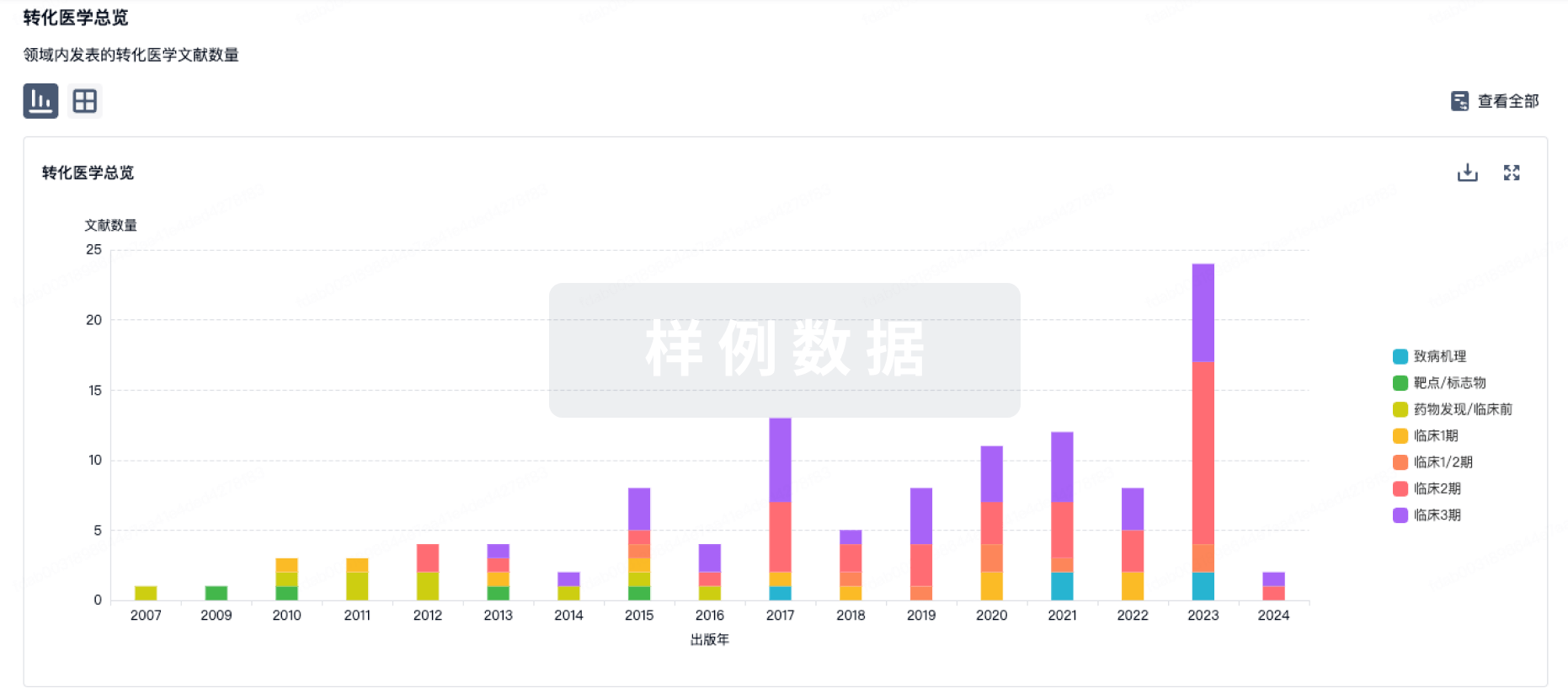
药物交易
使用我们的药物交易数据加速您的研究。
登录
或
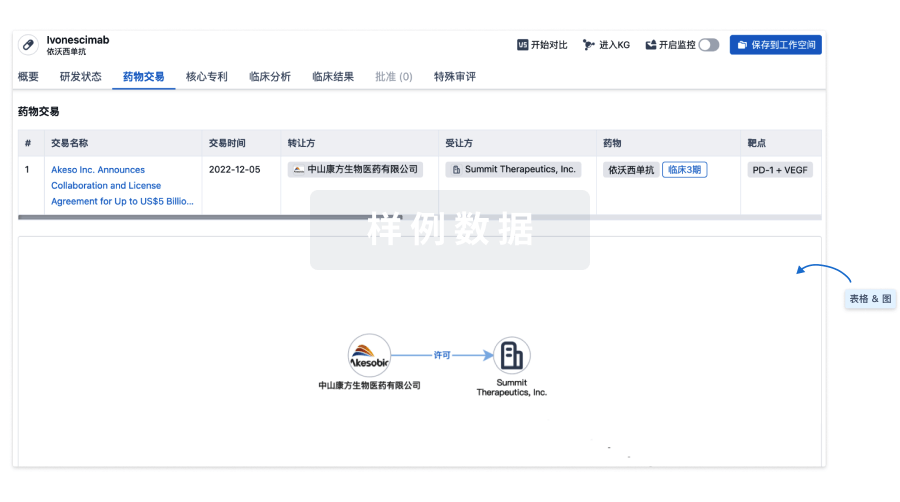
核心专利
使用我们的核心专利数据促进您的研究。
登录
或
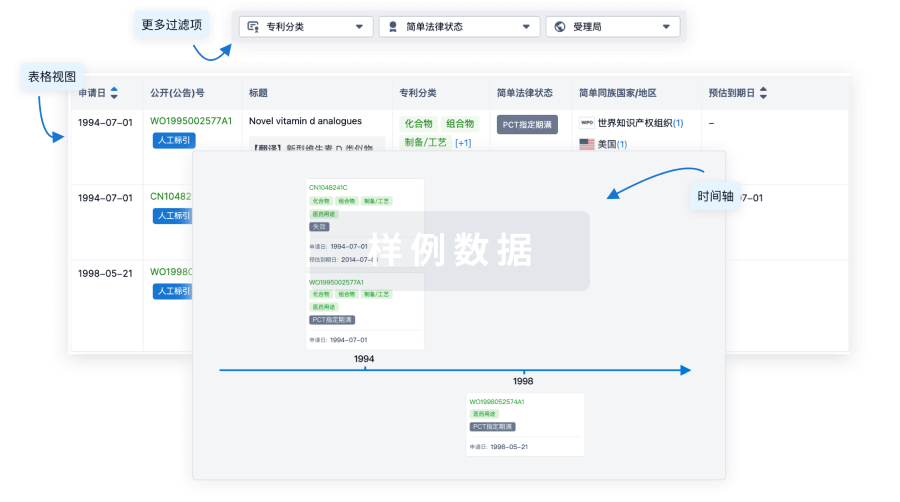
临床分析
紧跟全球注册中心的最新临床试验。
登录
或
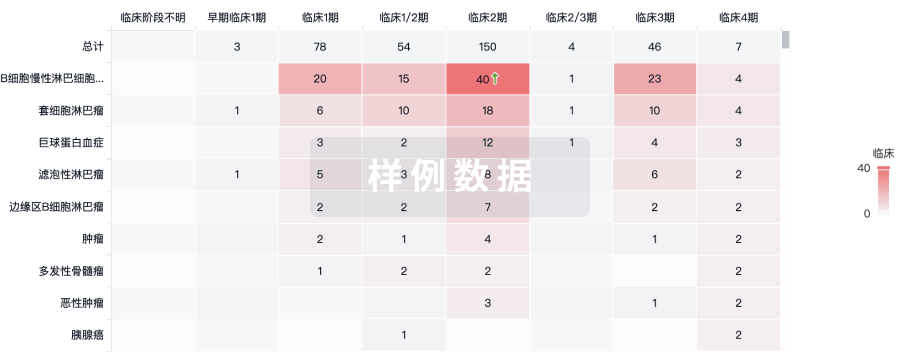
批准
利用最新的监管批准信息加速您的研究。
登录
或
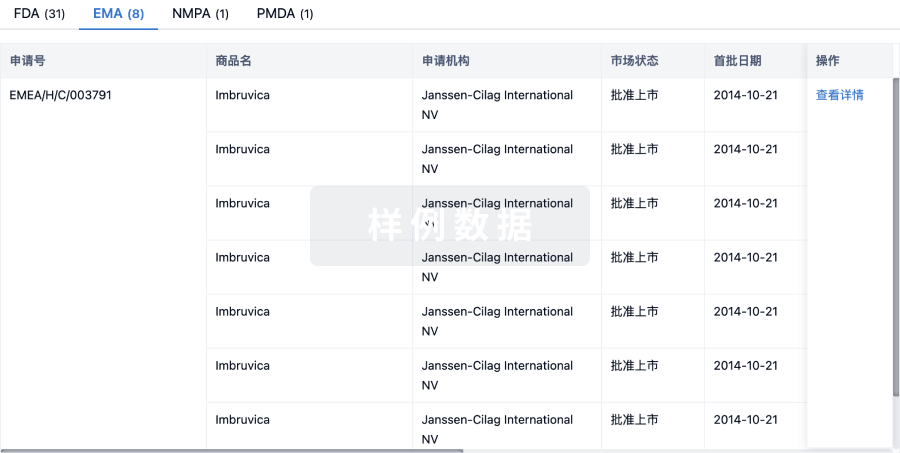
特殊审评
只需点击几下即可了解关键药物信息。
登录
或

Eureka LS:
全新生物医药AI Agent 覆盖科研全链路,让突破性发现快人一步
立即开始免费试用!
智慧芽新药情报库是智慧芽专为生命科学人士构建的基于AI的创新药情报平台,助您全方位提升您的研发与决策效率。
立即开始数据试用!
智慧芽新药库数据也通过智慧芽数据服务平台,以API或者数据包形式对外开放,助您更加充分利用智慧芽新药情报信息。
生物序列数据库
生物药研发创新
免费使用
化学结构数据库
小分子化药研发创新
免费使用

